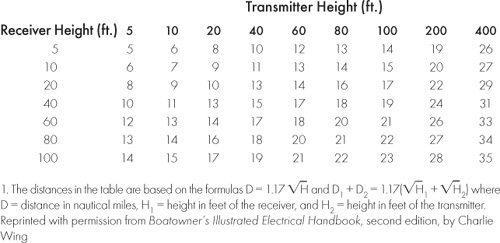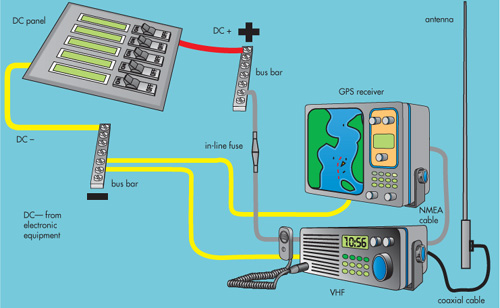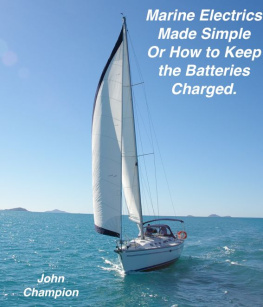Edwin Sherman - Advanced Marine Electrics and Electronics Troubleshooting
Here you can read online Edwin Sherman - Advanced Marine Electrics and Electronics Troubleshooting full text of the book (entire story) in english for free. Download pdf and epub, get meaning, cover and reviews about this ebook. year: 2007, publisher: McGraw-Hill Education, genre: Home and family. Description of the work, (preface) as well as reviews are available. Best literature library LitArk.com created for fans of good reading and offers a wide selection of genres:
Romance novel
Science fiction
Adventure
Detective
Science
History
Home and family
Prose
Art
Politics
Computer
Non-fiction
Religion
Business
Children
Humor
Choose a favorite category and find really read worthwhile books. Enjoy immersion in the world of imagination, feel the emotions of the characters or learn something new for yourself, make an fascinating discovery.

- Book:Advanced Marine Electrics and Electronics Troubleshooting
- Author:
- Publisher:McGraw-Hill Education
- Genre:
- Year:2007
- Rating:3 / 5
- Favourites:Add to favourites
- Your mark:
- 60
- 1
- 2
- 3
- 4
- 5
Advanced Marine Electrics and Electronics Troubleshooting: summary, description and annotation
We offer to read an annotation, description, summary or preface (depends on what the author of the book "Advanced Marine Electrics and Electronics Troubleshooting" wrote himself). If you haven't found the necessary information about the book — write in the comments, we will try to find it.
Edwin Sherman: author's other books
Who wrote Advanced Marine Electrics and Electronics Troubleshooting? Find out the surname, the name of the author of the book and a list of all author's works by series.
Advanced Marine Electrics and Electronics Troubleshooting — read online for free the complete book (whole text) full work
Below is the text of the book, divided by pages. System saving the place of the last page read, allows you to conveniently read the book "Advanced Marine Electrics and Electronics Troubleshooting" online for free, without having to search again every time where you left off. Put a bookmark, and you can go to the page where you finished reading at any time.
Font size:
Interval:
Bookmark:
14
Installing Communications and Position-Finding Systems and Radar
.

Proper installation of communications equipment, position-finding GPS-based systems, and radar is serious business. Boatowners rely on this gear to ensure their safety and, if necessary, call for help, perhaps in a life-threatening situation. Such equipment is vital to the safe operation of a boat, in contrast to, for example, installing a CD player. Yes, a CD player is a piece of electronic equipment, but if the boatowner can't hear the latest Alan Jackson CD while underway, it's not a crisis. So, please, as you read through the material that follows, approach your work as though you might be helping to save someone's life. Don't cut corners.
Communications systems on boats used to entail perhaps just a VHF radio. But nowadays most boaters consider SSBs, cell phones, satellite TV and/or Internet access basic requirements. And of course, all this additional equipment means more work for marine technicians!
VHF radio is the most common of all marine electronic equipment used for boat-to-boat and boat-to-land communication. It operates in the frequency range of 156 MHz to 174 MHz. In recent years, features such as digital selective calling (DSC), global positioning system (GPS), and the Global Maritime Distress and Safety System (GMDSS) have expanded the use and functionality of VHF radios by incorporating the ability to transmit time, position, and ownership information in the event of an emergency. While improving safety at sea, these features have altered the VHF's traditional installation procedure, so we'll review the installation process.
In the United States, the transmitting power for marine VHF is limited by the FCC to a maximum of 25 watts. Canadian regulations mirror the U.S. regulations in this area. (Land-based units can have much higher power under the regulations.) I have found that
TABLE 14-1 Line-of-Sight Distance, D1 + D2, for VHF Radios1

estimating 1 statute mile per watt of transmitting power is a fairly reliable rule of thumb for the expected range of a VHF radio. For example, a 5-watt handheld VHF would have a 5-mile range, and so forth.
With transmitting power limited by law, one of the only practical methods of increasing a VHF radio's effective range is to locate the antenna higher. Since VHF operates on a line-of-sight basis, raising the antenna extends its range by extending the effective horizon (see ).
We will look further at issues relating to the antenna and the coaxial cable that connects it to the radio in .
Since low voltage to the radio will dramatically affect its performance, proper wiring using the correct gauge to ensure minimum voltage drop, and high-quality termination points, are critical to the installation.
Installation guidelines:
- Use the wire gauge as specified by the manufacturer for the DC power feed and negative return.
- Install wiring to keep voltage drop to the maximum of 3% based on ABYC standards.

Line-of-sight transmit/receive distances for VHF radio. (Reprinted with permission from Boatowner's Illustrated Electrical Handbook, second edition, by Charlie Wing)

The wiring and cable connections to a VHF radio. Notice the interface with the GPS receiver via an NMEA cable link.
- Follow Standard E-11 to determine the appropriate wire size to use. Remember that wire size is based on the length of the wire run from the power source to the VHF radio (see the ABYC voltage drop table, page 43).
DSC is integrated into all new VHF radios and is a part of GMDSS. The interface between the VHF radio and GPS receiver allows position information to be transmitted in the event of a DSC emergency call; all you have to do is push the emergency button now found on all new radio sets to transmit your boat's exact position and time data to the U.S. Coast Guard.
Installation guidelines:
- Use an NMEA-approved cable attachment to link your VHF radio to the GPS unit (see above illustration). (This interface may be part of your boat's network; see for more on networking.)
- Follow the manufacturer's recommendations for the exact terminal connections.
As the last step to a fully capable DSC installation, the boatowner must acquire a Maritime Mobile Service Identity (MMSI) number. Once entered, this nine-digit number becomes the permanent identifier for your boat. When DSC is activated, the MMSI will provide rescue personnel with pertinent boat and owner information along with time and position data.
In the United States, you can get an MMSI from the FCC for a fee, or for free by contacting BoatU.S. ( www.boatus.com/mmsi ) or Sea Tow ( www.seasmartvhf.com ). In Canada, all applications for MMSI numbers must be
DEVIATION THE HARD WAY |
A few years ago, I learned my lesson about electronics-induced compass deviation the hard wayalmost literally. My 25-foot walkaround has a very compact helm station, and all the electronic equipmentGPS chartplotter, fishfinder, water temperature gauge, and VHF radiowas tightly clustered at the helm. In the center of the cluster, and no more than 12 to 18 inches from any of them, was the magnetic steering compass. |
When my VHF radio failed, I bought a new unit, complete with all the bells and whistles, and mounted it in the same location as the original unit. I tested it and it worked fine. Several weeks later, I was fishing on Narragansett Bay when a thick fog rolled in. I decided to head for home, and checked the chartplotter for the magnetic heading I would need to get to the breakwater at the entrance to my home port. |
Off I went, paying more attention to the compass than the chartplotter and following the predetermined heading using the steering compass. About the time I thought I should see the breakwater, it suddenly appeared about 100 feet dead aheadnot the opening in the breakwater, where my heading should have positioned me, but the wall itself. Fortunately I was cruising slowly at 5 knots, and was able to avoid disaster. But what had happened? |
After replotting everything, I realized that I had a 12-degree deviation in my compass. The cause was simple to figure out. I'd never had a lick of deviation in that trusty Ritchie compass until I installed the new VHF. The speaker magnets in the new radio were much more powerful than those in the old unit, and they had caused this new deviation. |
I removed the radio and reinstalled it in a new location, away from my compass but still ergonomically placed for ease of use. Another lesson learned, and almost the hard waybreakwater hard! |
submitted to the Canadian government directly via Industry Canada. To learn more about their process, go to http://strategis.ic.gc.ca/epic/internet/insmt-gst.nsf/en/sf01032e.html .
Font size:
Interval:
Bookmark:
Similar books «Advanced Marine Electrics and Electronics Troubleshooting»
Look at similar books to Advanced Marine Electrics and Electronics Troubleshooting. We have selected literature similar in name and meaning in the hope of providing readers with more options to find new, interesting, not yet read works.
Discussion, reviews of the book Advanced Marine Electrics and Electronics Troubleshooting and just readers' own opinions. Leave your comments, write what you think about the work, its meaning or the main characters. Specify what exactly you liked and what you didn't like, and why you think so.








